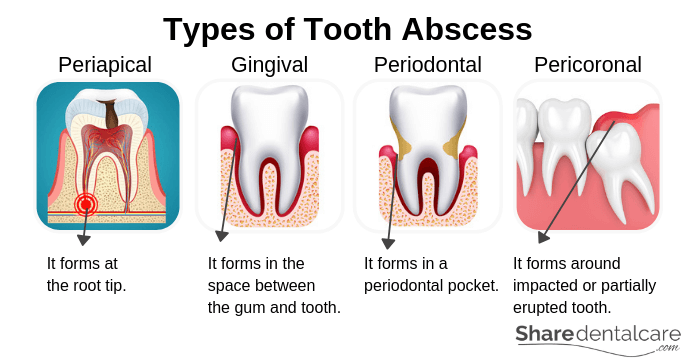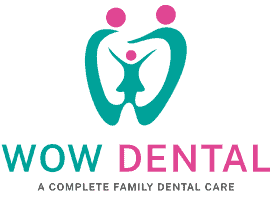What is Dental abscess?
Dental abscess is a pocket of pus that can form in different parts of a tooth as a result of a bacterial infection. An abscessed tooth causes moderate to severe pain that can sometimes radiate to your ear or neck.
Left untreated, an abscessed tooth can turn into a serious, life-threatening condition.
What are the different types of Dental abscess?
Depending on location the three most common types are:
- Periapical abscess: This is an abscess at the tip of a tooth’s root.
- Periodontal abscess: This is an abscess on the gum next to the root of a tooth. It might also spread to the surrounding tissue and bone.
- Gingival abscess: This is an abscess on the gums.

What are the symptoms of Dental abscess?
The main symptom is throbbing pain near a tooth or in your gums. The pain sudden in onset and gets worsen over time.
Other symptoms include:
- Pain that radiates to your ear, jaw, or neck
- Pain that gets worse when you lie down
- Pain when chewing or biting
- Facial redness and swelling
- Bad breath
- Fever
What are the causes for Dental abscess?
- Periapical abscess: Bacteria enter the pulp within your teeth, usually through a cavity and irritates the pulpal tissue in the root and finally ends in the development of perapical abcess at the root end.
- Periodontal abscess: inflammation in the gums usually causes this type, but it can also be the result of an injury.
- Gingival abscess: Foreign bodies such as food or toothbrush bristle, if gets embedded in your gums cause irritation of the gums and further leading to development of abscess.
How to treat Dental abscess?
Treatment for an abscessed tooth focuses on clearing up the infection and relieving pain. Depending on your symptoms, your dentist might start with a dental X-ray. This will help them see whether the infection has spread to other areas.
Depending on the type and severity of your abscess, treatment options include:
- Draining the abscess. Your dentist will make a small cut in the abscess to drain the pus and clean the area with an anti-septic solution.
- A root canal procedure. A root canal involves drilling into the affected tooth to drain the abscess and remove any infected pulp. Next, your dentist will fill and seal the pulp chamber, which holds pulp, and the root canal. They will cap your tooth with a crown to avoid fracture of tooth. A crown procedure is usually done during a separate appointment.
- Tooth extraction. If your tooth is too damaged, your dentist might remove it before draining the abscess.
- Antibiotics. If the infection has spread beyond the abscessed area or you have a weakened immune system, your dentist might prescribe oral antibiotics to help clear the infection.
- Removal of foreign object. If your abscess is caused by a foreign object in your gums, your dentist will remove it. They’ll finish up by cleaning the area with an anti – septic solution.
How to prevent Dental abscess?
- Proper oral hygiene maintenance.
- Proper brushing technique and Fluoridated tooth paste– 2/day.
- Flossing regularly.
- Regular dental visits –once in every 6 months.
- Restoration of decayed tooth in early stage.
What are the things you should avoid with dental abscess?
- Avoid hot fomentation as it causes sudden increase in size of swelling.
- Don’t keep local medications like campher or cinnamon in cavited tooth it will worsen the situation.
